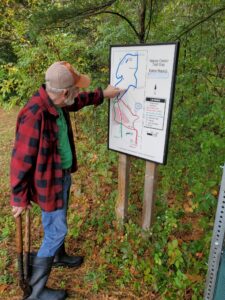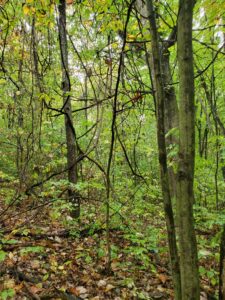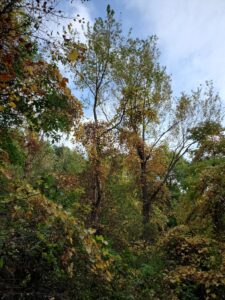Grape vines have some benefits, but they can at times get out of hand.
It had rained on and off all day, and the humidity was causing our clothing to cling worse than velcro. Even though it was early October, the warm and wet weather encouraged the mosquitos to hum around our heads. Still, we hacked off the trail in search of our woody quarry. Our target was threatening the health and survival of many mature trees. Today, it was our job to begin their liberation. We came to rein in the wild grape.
Wild grape (Vitis spp) covers many different grape species across North America. Most in Michigan are riverbank grape (Vitis riparia). The name suggests it’s found along waterways, but it grows in a much wider set of conditions. It tolerates sandier soils, flooded sites, and more alkaline conditions. You can find them growing between rocks in stone quarries, along heavily disturbed ditches and roadsides, and in shady forest interiors.
And yes, the grapes are edible, though many say they’re pretty sour until the first frost (just don’t confuse them with the invasive porcelain berry, which are poisonous). The woody vines themselves are often used for wreathmaking as well. The best value of this vine is its benefit to both birds and four-legged mammals, who usually beat humans to the fruits. Birds also frequently use grape thickets as cover and nesting habitat.
With all these benefits come some tangled issues. Sometimes grape vines can be a bit too successful. The vines can grow up to 35 feet or so with the right structural support—which is usually in the form of mature trees. In the vines’ enthusiasm for grabbing sunlight (like all green plants), the vines can quickly spread into a tree’s crown and across the forest canopy. The sheer weight of the vines and leaves can weigh down the tree to the point of breakage. The vines’ leaves also can crowd out tree leaves, reducing their ability to photosynthesize and create enough food for itself to survive. This competition can be very intense in certain forest locations, especially along edges of fields or other openings.

This exact thing has been happening in a former school forest in Eaton Rapids. Bill Botti has been working with the city and Eaton Township to ‘liberate’ some of the forest areas from grape vine invasion in what is now Oak Ridge Park. What is the best way to ‘save’ the trees from the climbing menace? Get out there with pruners, loppers, and heavy gloves and hack away! The vines themselves are easy to spot if you’re walking under the trees—the shreddy bark is unique among local vines as they hang down under the canopy.

Here is a ‘before’ picture of the grape invasion. Hopefully we can visit next year to see what kind of progress the vine clipping made. Stay tuned!

